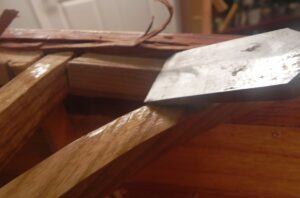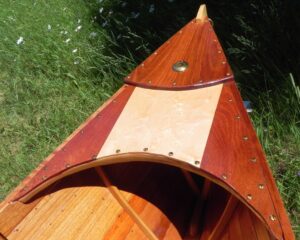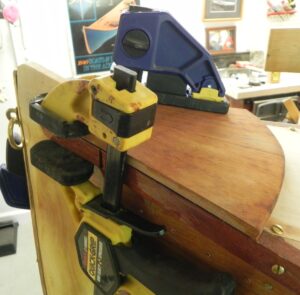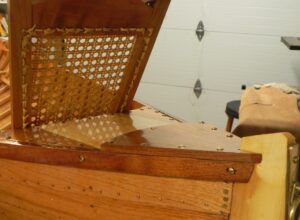When you are finally getting to making the decks you know you are nearly done. There is a clever display at the Adirondack Museum that speaks to the decks. It is next to the boat shop where Allison creates her marvelous guideboat renditions. It is a full size guideboat that is cutaway to show its different parts. A narration goes along with it. Every time a visitor pushes a button the boat rotates and the narration begins. I have heard it hundreds of times. One part stresses the importance of the guideboat’s decks to the builder. The narrations goes something like this ” Guideboats are remarkably similar in design. Guideboat builders used the decks to display their individuality”.
The decks were used to hide the hand holds for lifting and carrying the craft. Decks consist of three parts, the deck bridge, the deck itself, and the deck cap. Here is the deck bridge.

The bridge consists of the carlin, the curved piece, and a straight member. They are made of ash.
In order for the deck to fit flush with the gunwale I have to cut away some of the planking to make a rabbet.

Builder Caleb Chase employed an uncommon twist to the decks he built. They have a crown made by making the bridge higher in the center than on the edges. The crown is only about 1/2″ higher than the edges but, in my opinion, it has a dramatic effect on the appearance of the boat. It is a subtlety but conveys a sense of “motion” to a stationary boat.
I made my decks of a central panel of bird’s eye maple flanked by pieces of Spanish cedar. Jumping ahead, here is the finished bow deck.

The crown doesn’t cause any consternation with assembling the deck but it sure does with the deck cap. That is because the deck is only about an 1/8″ thick while the cap is 3/8″ thick. I struggled with how to get the caps to conform to the crown. My wife happened by while I was stymied and said why don’t you use your old trick, water? So I did. I took a water soaked rag and draped it over the cap.

After a few hours of soaking the cap conformed nicely. But as soon as it dries out it will go right back to its original shape. To prevent that from happening I clamp it down.

Here the cap has dried after being clamped. It fits quite nicely.

The decks are fastened with #8 oval head brass screws. The oval heads give it a classy look.
Here is the stern deck after varnishing.

Note the feed thru on the bow deck in the photo above. It was originally used to hold a candle lantern when “floating” for deer in times gone by.
Next time we head north to Long Lake for a photo op and launching.